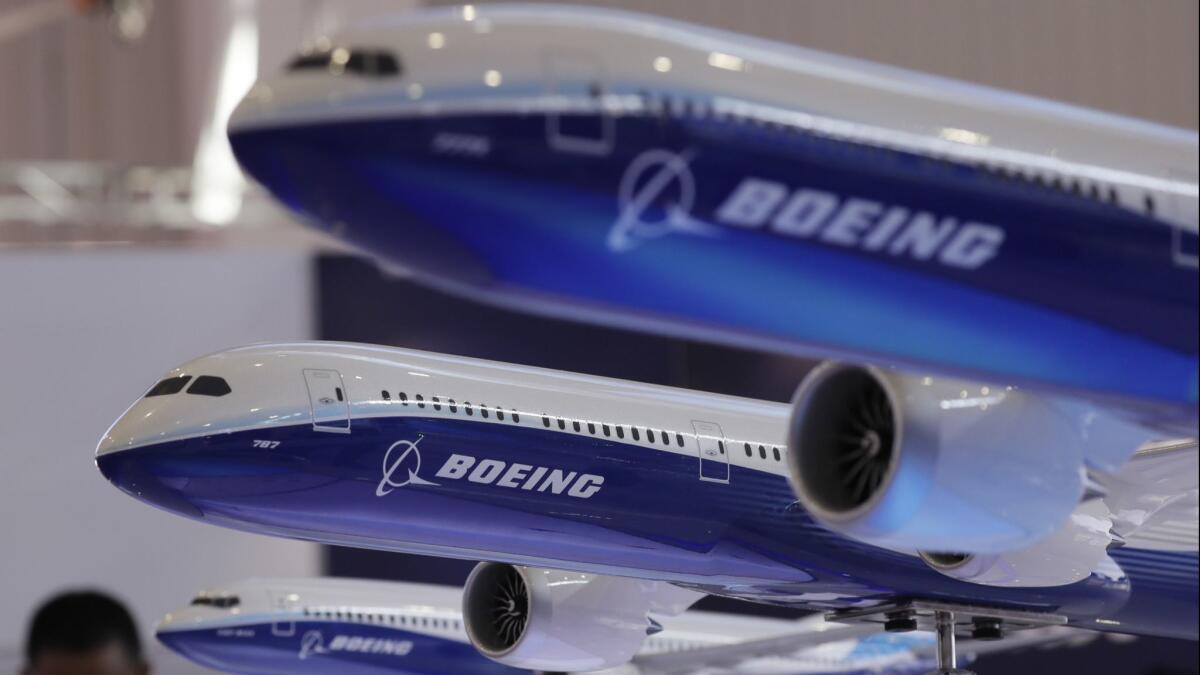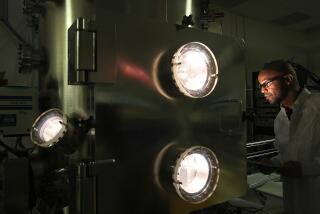As aerospace giants grow, suppliers find ‘their largest customer may be their largest competitor’

With $93 billion in 2017 revenue and 141,000 employees, Boeing Co. was massive enough. But over the last year, the aerospace giant has steadily expanded beyond its traditional expertise in commercial jets, big satellites and fighters, gobbling up providers of parts and services.
In October, Boeing acquired aerospace parts distributor KLX Inc. for $4.25 billion, the company’s largest acquisition since its blockbuster merger in 1997 with rival McDonnell Douglas Corp. Chicago-based Boeing had previously proposed a joint venture with Brazilian aerospace firm Embraer, secured partnerships with suppliers of airplane seats and auxiliary power units, and bought small-satellite manufacturer Millennium Space Systems in El Segundo.
Boeing isn’t the only aerospace company that’s bulking up. L3 Technologies Inc. and Harris Corp. said in October they planned to merge, creating the sixth-largest U.S. defense company.
As defense funding increases and demand for commercial aviation and space grows, aerospace firms are looking toward acquisitions and other partnerships to add heft and diversity. For the hundreds of smaller companies in Southern California and elsewhere that supply the giants, the wave of consolidation presents opportunities and challenges.
“In some cases, for the [original equipment manufacturers], their largest customer may also be their largest competitor,” said Daniel Adamski, executive vice president of distribution at Kellstrom Aerospace, an aircraft parts supplier based in Miami Lakes, Fla.
Global aerospace mergers and acquisitions totaled $30.3 billion through September, the latest data available through consulting firm PwC. That figure doesn’t include the Harris and L3 deal and other recent big ones, and it was down 49% compared with the same period last year, when United Technologies Corp. paid $23 billion, excluding debt, for Rockwell Collins and Northrop Grumman Corp. bought Orbital ATK Inc. for $7.8 billion.
The giants have been so active they’re running low on targets. “The opportunities to consolidate companies of this size are diminishing,” said Scott Thompson, U.S. aerospace and defense practice leader at PwC. “I do see the trends continuing, but I don’t foresee it continuing at the values we’ve seen.”
Industry experts point out that these tie-ups are different from those that followed the collapse of the Cold War in the 1990s, when a downturn in defense spending pushed Lockheed to combine with Martin Marietta and Boeing to acquire McDonnell Douglas.
“Rather than trying to consolidate in a shrinking market and cutting costs, companies are positioning themselves for growth,” said Andrew Hunter, director of the defense industrial initiatives group at the Center for Strategic and International Studies think tank in Washington.
In October, L3 and Harris officials described their $33.5-billion merger, not captured in the PwC report, as a way to compete for bigger government contracts.
“When I sit back, I look at the power that this enterprise will create,” William Brown, chief executive of Harris, said during an October conference call with analysts. “Our positions in electronic warfare really makes the combined company a much stronger competitor in spectrum warfare, networked battlefield.”
On the commercial aircraft side, Boeing’s acquisition of KLX and its joint ventures with suppliers such as automotive seat firm Adient and French engine manufacturer Safran are part of the aerospace giant’s plans to offer more services, including repair and overhaul capabilities. Commercial rival Airbus is making similar moves.
Suppliers traditionally provided those services, which can be more profitable than providing parts to aircraft manufacturers, said Adamski of Kellstrom Aerospace.
Boeing’s move into the so-called aftermarket gained traction in 2006 when it acquired Aviall Inc., which provides new aviation parts and aftermarket services. Last year, Boeing established a new business unit called Boeing Global Services to provide services to commercial and government customers. A company statement at the time estimated the worth of that combined market at $2.6 trillion over the next 10 years.
Before the creation of the unit, the company had aircraft support operations embedded separately in its commercial aviation and defense businesses, said Stan Deal, chief executive of Boeing Global Services.
“It was all about better serving our customers, creating an environment that matched how our customers tended to operate, which is a fast-paced dynamic,” he said.
Ken Shaw, senior vice president of supply chain solutions, said the company heard “quite a bit” from customers that they wanted Boeing to have a “wider service products offering.”
Vertical integration allows aircraft manufacturers to exert more control over their supply chains and better predict and deal with potential problems that arise, said Jim Adams, leader of the aerospace and defense practice at KPMG.
Boeing’s share price climbed through much of its dealmaking but has been slammed recently over fears of a trade war with China, its biggest overseas customer. The stock is down 17% since the beginning of October, but still up 10% for the year.
Deal said Boeing’s service unit looks to develop capabilities in-house before eyeing the landscape for acquisitions. Much of its attention has been focused on developing its own aircraft avionics and auxiliary-power engines, which are used to start an airplane’s main engines in the case of an emergency and to power systems such as a plane’s lighting.
In those areas, the company plans to make “very deliberate investment into those areas and depend more on Boeing capability over our supply chain,” Deal said. But in other areas, he said, “we’ll continue to buy” from suppliers.
Boeing’s moves have created “a kind of nervous excitement” among suppliers, an industry executive said.
“There’s a lot of unknowns,” said Collin Jager, president of Aerofied, a Torrance company that connects aerospace and defense companies with suppliers. “But at the same time … they just opened their market tremendously.”
For example, he said, companies that supplied Orbital ATK could potentially target new and additional business opportunities with Northrop Grumman after the acquisition was approved in June.
But vertical integration can also decrease competition, raise prices for commercial airlines and the Pentagon, and edge out the companies that had been selling those parts or services.
“It’s a way of creating significant leverage for negotiation with their Tier One partners to moderate pricing … and allowing them to keep more of the margin, if you will,” said Adamski of Kellstrom Aerospace of air-frame manufacturers.
After Boeing announced its joint venture to produce airplane seats with Adient, Safran executives tried to downplay concerns about how the partnership would affect its seat manufacturing business. Most of the business comes directly from airlines and “they like competition and they like to discuss directly with the seat manufacturers,” said Philippe Petitcolin, chief executive of Safran.
“We just have to do our job, be [an] innovator and propose good products that we will deliver on time,” Petitcolin said during a February call with analysts after Safran completed its acquisition of seat manufacturer Zodiac Aerospace. “As long as we master our own quality, our own delivery and our own performance, I believe that there is plenty of room for Zodiac, Safran to continue to grow the business.”
“But,” he said of the joint venture, “it’s a competitor.”
Boeing’s Deal acknowledged that the company’s acquisition strategy could affect suppliers but said most of the supply chain adapts to the current environment.
“They either transform [or] reinvest somewhere else, and we’re comfortable with that dynamic,” he said. “It sharpens people’s focus, which is important for the overall competitiveness of the industry.”
Anthony Previte, chief executive of Terran Orbital, an Irvine-based small-satellite manufacturer and data analysis firm, was looking at the bright side of Boeing snapping up his rival, Millennium Space Systems.
“In my mind, a competitor is gone,” he said.
He said Millennium was known for its agility and its culture may not fit with that of a traditional contractor. The government “is trying to procure from multiple buyers aggressively,” Previte said. “It’s harder for traditional business to adapt to that.”
Twitter: @smasunaga







